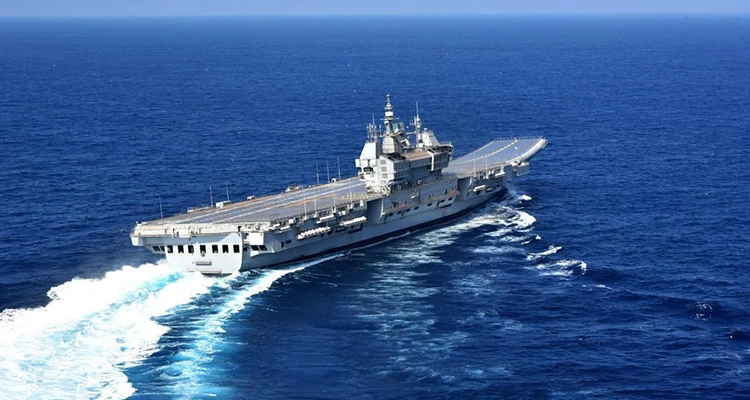The Indian Air Force (IAF) Thursday test-fired the Extended Range Version of BrahMos Air Launched missile against a ship target from a frontline SU-30MKI aircraft in the Bay of Bengal region.
INS Vikrant: India's First Indigenously Designed Aircraft Carrier
The first ever aircraft carrier to be indigenously designed and constructed, the much-awaited INS Vikrant was launched by Prime Minister Narendra Modi on 2 September 2022. INS Vikrant will give a much-needed fillip to India’s military equipment ecosystem and the quest to be self-reliant in defence equipment.
Read Time: 13 minutes
click play to listen to the article
The first ever aircraft carrier to be indigenously designed and constructed, the much-awaited INS Vikrant was launched by Prime Minister Narendra Modi on 2 September 2022. With it, India joins the elite group of nations – the US, Russia, France, the UK and China – who are capable of designing and constructing aircraft carriers. INS Vikrant will strengthen the country’s standing as a maritime force with global reach and capability to operate over deep seas. The commissioning of INS Vikrant is a momentous occasion during the ‘Amritkaal of India’s 75 years of independence and signifies the country’s confidence and prowess.
The Name
The Sanskrit word Vikrant means courageous. As far as the origin of the word goes, the ‘Vi’ prefix in the Sanskrit word denotes something that is distinctive or extraordinary, and the ‘krant’ suffix means to move or advance in a direction. Vikrant finds mention in various scriptures including the Bhagwad Gita. The sixth shloka in the first chapter of the Gita, while describing the valor of Generals from the army of Pandavas, uses the adjective ‘Vikrant’. INS Vikrant also carries the motto — जयेम सं युधिस्पृध: (Jayema Sam Yudhi Sprudhah) — a verse from the Rigveda which means, “I conquer those who fight against me”.
Aatmanirbhar Bharat
Every part of INS Vikrant has its own merits, a strength, a development journey of its own. It is a symbol of indigenous potential, indigenous resources and indigenous skills. The plan for building an indigenous aircraft carrier started taking shape as the old INS Vikrant neared its decommissioning in the late 1990s. INS Vikrant is designed by the Indian Navy’s in-house warship design bureau (WDB), under the Cochin Shipyard Limited (CSL), a public sector shipyard under the Ministry of Ports, Shipping and Waterways. The design was sanctioned in January 2003. Several design iterations, including the use of 3D Virtual Reality models and advanced engineering software, were used by the Directorate of Naval Design in shaping the design of the carrier.
The Defence Research and Development Organisation (DRDO)’s Defence Metallurgical Research Laboratory (DMRL) in Hyderabad and the public sector Steel Authority of India or SAIL jointly developed three types of steel for the carrier, ultimately supplying some 23,000 tons of it to CSL, and using it thereafter for other naval platforms, including nuclear-powered attack submarines. Varying in thickness from 3 mm to 70 mm this steel included DMR 249A for the carriers’ hull and body, while the more resilient DMR 249B variant was used for the flight deck that takes repeated beatings from the impact of 15-18 ton fighter’s landing frequently upon it. The third steel type — DMR Z25, was used for flooring in many of Vikrant’s compartments housing heavy equipment, like engines and generators, as it was capable of withstanding compression and decompression emanating from these apparatuses. The special kind of steel for the entire ship except for the bulb bars has been supplied by the steel plants present at Bhilai, Bokaro and Rourkela.
CSL also competently employed the modular integrated hull outfit and painting (IHOP) technique in IAC-1’s construction. This included the latest shipbuilding techniques, which comprised readying 874 composite compartment blocks, each averaging 250 tons that incorporated most of Vikrant’s machinery employed for navigation and overall survivability.
Over 90% of the hull, 50% of the machinery and 30% of weapons and sensors are designed and built with materials made in India. The ship has a large number of indigenous equipment and machinery, involving major industrial houses in the country viz. BEL, BHEL, GRSE, Keltron, Kirloskar, Larsen & Toubro, Wartsila India etc. Over 550 OEMs, sub-contractors, and ancillary industries, and over 100 MSMEs, were part of the carrier’s journey from steel to potent warship. INS Vikrant has been built at an approximate cost of Rs 20,000 crore, almost one-fifth the cost of a regular aircraft carrier. The Navy said that around 80 to 85% has been ploughed back into the Indian economy with complete indigenous construction — 76% indigenous content and with employment given to more than 2,000 personnel directly, while 40,000 more people were employed indirectly.
Milestones
The first major milestone for INS Vikrant was ceremonial steel cutting in April 2005. In any ship’s life there are four key ceremonial occasions — keel laying, launching, commissioning and decommissioning. For modern ships, keel laying is marked by placing the first of the modular components of the ship being placed in the dock. The keel of the INS Vikrant was laid on 28 February 2009. Launching is when the ship is transferred from the building site into the waters. INS Vikrant was launched on 12 August 2013 and by that time, 80% of its structure had been fabricated and all the major machinery including turbines, alternators and gearboxes were installed. It was launched out into the Ernakulam Channel in a pontoon assisted precision manoeuvre. It was moved out of the building dock to be positioned in the refitting dock where the next phase of outfitting was completed. On 10 June 2015, INS Vikrant was undocked. The readiness of its propulsion and power generation equipment and related systems was tested in harbour as part of basin trials in November 2020. On 4 August 2021, the first phase of sea trials kicked off with INS Vikrant sailing on its first open sea voyage from Kochi, and returning four days later. This was followed by second and third phases of sea trials in October 2021 and January 2022, respectively. These three phases tested the propulsion machinery, electrical and electronic suites, deck machinery, life-saving appliances, ship’s navigation and communication systems. Fourth and final phase of sea trials for INS Vikrant was completed on 10 July 2022 after conducting integrated testing of the majority of the equipment and systems onboard, including some of the Aviation Facilities Complex equipment. The ship was delivered to the Navy on 28 July 2022. INS Vikrant is expected to be fully operational by mid-2023.
Specifications
With a displacement of 43,000 tons when fully loaded, INS Vikrant is set to be the seventh largest among the carriers or carrier classes in the world. The INS Vikrant is 262 metres (~860 ft.) long and 60 metres (~197 ft.) wide, making its flight deck bigger than two football fields. The aircraft carrier has a maximum designed speed of 28 knots (52 km/hr) with endurance of 7,500 nautical miles, which is equivalent to around 14,000 km. Its flight deck size is nearly 12,500 sq. m — almost as big as two-and-a-half hockey fields. It has 250 tankers of fuel capacity.
The 18-floor high ship has close to 2,400 compartments, designed to house 1,600-strong crew. It also has specialized cabins to accommodate women officers and sailors. The aviation hangar is as big as two Olympic-size pools that can accommodate around 20 aircraft. There is a well-equipped kitchen that can serve a diverse menu. It also has a unit that makes 3,000 rotis per hour. Close to 600 personnel can have their meals at the same time.
INS Vikrant’s medical complex has a 16-bed hospital along with modular emergency operation theatre, physiotherapy clinic, Intensive Care Unit, pathology set up, radiology wing with a CT scanner and X-Ray machines, a dental complex, isolation ward and telemedicine facilities.
Also known as a floating city, the four engines of INS Vikrant can together build up 88MW of electricity — enough to light up to 5000 households. The wiring involved can reach from Kashi to Kochi.
Military Specs
The largest ship ever built in the maritime history of India houses state of the art automation features. INS Vikrant uses the Short Take Off but Arrested Recovery (STOBAR) model with a ski-jump for launching aircraft, and a set of three arrester wires for their recovery onboard. In its fully operational mode, the carrier will have an air wing consisting of 30 aircrafts, comprising of Russian-origin carrier-capable MiG-29K fighter jets and airborne early warning control helicopter Kamov-31 helicopters, US origin MH-60R multi-role helicopters. In addition, INS Vikrant’s air wing will boast of the indigenously manufactured Advanced Light Helicopters (ALH) and Light Combat Aircraft Tejas (Navy). The government is also looking to procure and equip the carrier with 26 either Boeing-manufactured F/A-18 Super Hornets or the Dassault-manufactured Rafale M fighter aircraft. These aircraft will at best be a stop-gap arrangement until the planned indigenously designed and built twin-engine deck-based fighter is ready by around 2032.
Vikrant was also armed with 32 Israeli-origin Barak-8 Medium Range Surface-to-Air missiles (MR-SAMs) that are manufactured by Bharat Dynamics Limited in collaboration with Israel Aerospace Industries (IAI)-Elta. These, in turn, were supported by the Israeli EL/M-2248 MF-STAR multi-function active electronically scanned array radar.
Significance
The commissioning of INS Vikrant will bolster the maritime security of the nation. Aircraft carriers like the INS Vikrant, along with their accompanying warships, tankers, and submarines, are self-contained carrier battle groups which offer tremendous flexibility of operations against shore-based targets, and in air defence, anti-submarine, and anti-ship roles. With this new addition to its fleet, India now has two aircraft carriers, 10 destroyers, 12 frigates, and 20 corvettes, making the Indian Navy the seventh most powerful in the world. This comes at a time when the Indo Pacific and the Indian Ocean are becoming hotbeds of competition due to their strategic significance. Several countries, including the United States and China, have been enhancing their naval capacities to garner greater influence in the littoral region.
INS Vikrant is a unique reflection of India becoming self-reliant. The commissioning of INS Vikrant marks a significant step for the Narendra Modi government’s pitch for self-reliance, especially in strategic sectors. It is a historical milestone of realization of the nation’s commitment towards Aatmanirbhar Bharat. The commissioning also signifies India’s growing aspirations to expand the navy into a truly blue-water navy. It also signals Modi government’s readiness to meet the growing strategic-security challenges posed by China. INS Vikrant will give a much-needed fillip to India’s military equipment ecosystem and the quest to be self-reliant in defence equipment.
Tags: The New India, Defence
Share this article:
Leave a Comment
Recommended For You
The people of the country found Damocles sword hanging over their heads during Congress tenures. The Congress tenure must serve as a reminder to us that never again shall we allow our fate to be put in the hands of such evil forces. Never ever!
It is only in India where the soldier not only fights the enemy but also the politician, the separatist, the journalist, the leftist, the human right activist and an assortment of opinions. It is time we stand together, show our soldier that we are not ungrateful, that we acknowledge and →Read More →
Prime Minister Narendra Modi dedicated to the nation, Hindustan Aeronautics Limited’s (HAL) new greenfield helicopter factory. This is not just India’s but Asia’s largest helicopter manufacturing facility, and a big step towards Aatmanirbhar Bharat.
Prime Minister Narendra Modi’s approach towards national security has been truly transformative. The Surgical Strikes were the first display of political resolve after years of indecisiveness in dealing firmly with threats.
Prachand — India’s first Made in India Light Combat Helicopter is another milestone towards self-reliance in the defence sector and Atmanirbhar Bharat initiative led by Prime Minister Narendra Modi.















